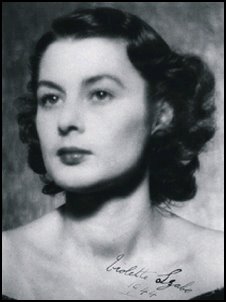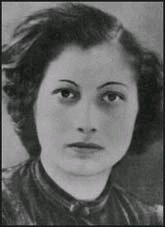
Posted on 02/21/2006 11:31:34 AM PST by 68skylark
Despite the fact that they are probably the most described artifacts of 20th century, very little is known about how individuals died in Third Reich's concentration camps. This article tries to follow the fate of British women SOE agents who were executed within the concentration camp system. It's a little surprising to learn that British intelligence never officially bothered to find out. Discovering their fate became the private crusade of Vera Atkins, who was assistant to the head of the French Section of the SOE. And the answer after 60 years is that nobody really knows. One of the reasons perhaps, was that nobody wanted to know. Failure, no less than the dead, were buried after the war. SOE cryptographer Leo Marks, the son of a Jewish bookseller, believed the agency's codes were fundamentally unsafe and tried to convince his superiors to adopt a one-time code pad system. But his warnings were ignored and the SOE continued to drop agents, many of them women, into occupied Europe where too many of them were arrested, sometimes upon landing.

Since the British believed that women could more easily slip unnoticed through the Continental streets, they concentrated on recruiting dark haired women who could pass for French. One of them was Violette Szabo of French and English extraction.

Another was a Sufi Muslim Princess, Noor Inayat Khan. Her father was a mystic and she was one herself. "After studying music and medicine Noor became a writer. Her children stories were published in Figaro and a collection of traditional Indian stories, Twenty Jataka Tales, appeared in 1939."

Szabo's official fate is given in Wikipedia.
She was captured by German soldiers, most likely from the 1st battalion of the Deutschland regiment, around mid-day on the 10th of June, 1944, near Salon-la-Tour, while they were searching for one of their missing officers. In R.J. Minney's biography of her, she is described as putting up fierce resistance with her Sten gun. German documents of the incident record no injuries or casualties to German soldiers. She was transferred to the SD in Limoges. She was interrogated under torture, then sent to Ravensbrück concentration camp where she was forced into hard labour and suffered terribly from malnutrition and exhaustion. Violette Szabo was executed by the Germans on or about February 5, 1945 and her body disposed of in the crematorium. At Ravensbrück, three other female members of the SOE were executed by the Germans: Denise Bloch, Cecily Lefort, and Lilian Rolfe.
Noor Inayat Khan was arrested four months after landing. She was executed at Dachau.
The princess was taken to Germany and imprisoned at Pforzheim in solitary confinement (she was considered dangerous and uncooperative). Inayat Khan continued to refuse to give any information on her work or her fellow operatives. On 11 September 1944, Noor Inayat Khan, along with three other SOE agents, Yolande Beekman, Eliane Plewman and Madeleine Damerment, were moved to Dachau Concentration Camp. The other three women were lined up and forced to kneel, after which each was executed by a single shot to the head. Noor was shackled in chains for months and beaten until she was a bloody mess and then shot. Her last word was "Liberté"
Although it cannot be said for sure, Khan's place of execution is held to be at the pistol range in Dachau. "The traditional method of execution was a shot in the neck at close range, which was the method used by the Nazis to kill traitors, spies, saboteurs and resistance fighters at a pistol range in front of a wall north of the crematorium. ... A ditch was dug about six feet from the execution wall to catch the flow of blood." A picture of the blood ditch is shown below as it appears today.

Leo Marks, as a Jew, felt himself no less an outsider than these dark-haired, expendable women. He tried long, and finally successfully, to get his SOE superiors to discard their amateurish practice of enciphering agent messages using transpositions based on well known ('the easier to memorize, Old Boy') English poems -- systems Marks could break with ease. When the SOE balked at one time pads he insisted that if agents were going to use poem codes, they ought at least to be original. The code-poem he wrote and gave to Violette Szabo on her wartime mission is a memorial to a time when a Muslim, Christian and Jew could find it in their hearts to fight Hitler with one word upon their lips: Liberte.
The life that I have
Is all that I have
And the life that I have
Is yoursThe love that I have
Of the life that I have
Is yours and yours and yours.A sleep I shall have
A rest I shall have
Yet death will be but a pause
For the peace of my years
In the long green grass
Will be yours and yours and yours.
That spirit is still alive today in many places. We shake our head at the appeasers and the pro-defeat crowd. But let's not forget our warriors overseas, and all the pro-victory, pro-freedom people everywhere. And that includes our allies, whether they're Muslim, Christian, or Jew, or whatever.
Fascinating - thanks for sharing it with us.
Thank you, an amazing and fascinating story, one that bears repeating. It amazes me, too, still. It's refreshing in this era of appeasers and pro-defeatists to hear of courage and be reminded that some still posess these qualities.
Good post. Thank you.
Agreed. One thinks of our Filipino allies in WW II, who were particularly brutalized by the Japanese---even worse than our "Death March" troops.
Good point. There are examples of this sort of resistance from all over the world during WWII. The Philippines offers especially strong examples.
Those last three months of the war took such a toll in the camps. So many, like Dietrich Bonhoffer, like Elie Wiesel's father, like these women, were executed or died from diesease so close to liberation.
If you go over to The Belmont Club, you'll see a second blog entry with photos and first-hand reports from the U.S. 45th Infantry Division at the liberation of Dachau. I'm a little surprised at the reports that U.S. troops mascaraed German guards. But I'm only a little bit surprised by these reports, and not very bothered by them.
The British recruited the Ghurkas, a group of fierce Indian soldiers, to paradrop into Japanese-held territory. When they got to the drop point, the British commander instructed them, in English, that they would jump at 1,000 feet.
When the sergeant-translator informed them, they became agitated, and the Brit commander asked what was wrong.
"Sahib, they request that we jump at 500 feet."
"They can't do that," said the Brit. "There wouldn't be enough time for their parachutes to open."
The sergeant smiled and spoke again to the men, who all nodded and grinned.
"It's fine Sahib."
"I don't understand, what was wrong?" asked the British officer.
The translator replied, "They didn't know they got parachutes, Sahib."
I researched the US Army's arrival at Dachau as my grandfather "did time" there, though before the camp's liberation in 1945. The troops were aghast at what they found. The pictures don't capture the stench and the sound. I would not use the word "massacre" to describe the US soldier's actions. They had seen their own slaughtered and still felt themselves in hot pursuit of the enemy. Also, they did not want to spend their time dealing with NAZI prisoners who would be a continuing burden -- and detract from their efforts, given limited resources -- to tend and possibly save the innocent. Consider it battlefield triage. Do not be "bothered" at all.
Good article.
However, is there a moral, ethical, legal difference between these women spies & saboteurs and terrorists / sympethizers who infiltrate America today?
Let me clarify --- I am not looking for a simplistic America good, nazi socialists bad response because from a terrorists point of view, he is good and America is bad.
Your question is breathtaking. How can you ask such a thing?
Thanks! I think I heard that somewhere in the past. But it's been awhile and I'm very glad to hear it again.
I think you and I are pretty much in agreement here.
Warning! This is a high-volume ping list.
Quite easy actually. I am taking a morals & ethics course. Looking for discussion on this question because it is all but identical to one we are in the middle of working through.
Question stands, is there a moral & ethical difference between someone who is doing good (under their belief system) by doing harm to you; vs you when you (under your belief system) are the good guy.

Hannah Szenes (Senesh) was born to an assimilated Jewish family in Hungary. Her father, Béla Szenes, a journalist and playwright, died when she was six years old. She continued to live with her mother Katherine Szenes and a brother.
Szenes entered a private protestant girl's school open – with increased tuition – to Catholics and Jews. However, when she was elected to the school's literary society, she could not take the office in the anti-Semitic atmosphere. She joined Maccabea, a Hungarian Zionist student organization.
Szenes graduated 1939 and decided to move to study in the Girls' Agricultural School at Nahalal in Palestine. In 1941 she joined a kibbutz called Sedot Yam and also joined the Haganah. February 4, 1942 she visited Caesarea. In 1943 she enlisted in the British army. In 1944 she began paratrooper training in Egypt for the British SOE.
On March 15, 1944 she and her companions were parachuted into Yugoslavia and joined a partisan group. In May 13th, 1944, Hannah and her comrades crossed the Hungarian border in small groups. She was captured before she could begin her mission and was interned in the Horthy Miklos Prison where she was tortured. She did not talk even when the guards threatened to torture her mother as well. The mother was eventually released.
Szenes communicated with other prisoners with large cut-out letters she placed in her window one at the time. She tried to keep their spirits up by singing.
Hannah Szenes went on trial for treason on October 28, 1944. There was an 8 day postponment to give the judges more time to find a verdict, followed by another postponment, this one due to the appointment of a new Judge Advocate. Hannah was executed by a firing squad before the judges had even found her guilty. She kept diary entries up until her last day, November 7, 1944. Her remains were brought to Israel in 1950 and buried in the cemetery on Mount Herzl, Jerusalem.
Szenes' diary was published in Hebrew in 1946.
After the Cold War, a Hungarian military court officially exonerated her. Her kin in Israel were informed November 5, 1993.
Hannah Szenes is considered a national heroine to Israel, and is an inspiration to Jewish adults and children all around the world
Disclaimer: Opinions posted on Free Republic are those of the individual posters and do not necessarily represent the opinion of Free Republic or its management. All materials posted herein are protected by copyright law and the exemption for fair use of copyrighted works.